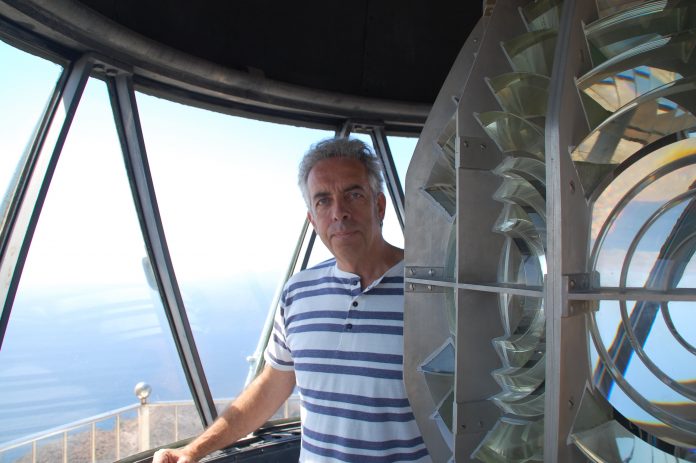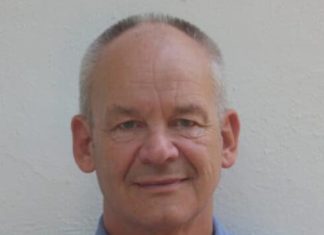
By Richard Torné
Think of a lighthouse and you’re likely to conjure up an image of a frail-looking tower, stoically resisting the crashing waves as it shines a comforting beacon for lost ships during a fearsome storm. Inside, a solitary lighthouse keeper stands dutifully at his post.
It’s the picture of grim solitude for most, perhaps, but for Mario Sanz, becoming the lighthouse keeper of Mesa Roldán in Carboneras was the best thing that ever happened to him.
“I don’t regret coming here at all. After I passed my entrance exams for lighthouse keeper I could have been sent anywhere but got posted here. I told my wife ‘you wanted the beach? Well, here it is’.” It helps that the couple have no children – and that his wife was “over the moon” with her husband’s career change.
At 55, he looks fit and healthy. A photograph dating from 1992 – a year before he became Mesa Roldán’s keeper – shows that his white hair was already a feature before he took on the job, which he admits is anything but stressful.
“In Almería we don’t get the terrible storms they get in Galicia – lightning is a far more common problem for us. I am also responsible for the upkeep of one buoy only, whereas in Galicia I’d have to maintain 30.”
His is a typical tale of the city dweller who turned his back on the hustle and bustle of the metropolis to start a new life in the unforgiving wilderness. “Before I became a lighthouse keeper I owned a bar in Madrid. We earned a lot of money but I had nothing to do in the mornings, so I started an official course on lighthouse keeping.”
He failed his first entrance exams (“I had no idea about electronics, or the sea”) but was more fortunate the second time around and was posted to Carboneras.
“The lighthouse was falling apart – the previous keeper was a nice chap, but very lazy.” Thankfully for him, the port authority renovated the installations months later – and he hasn’t looked back.
Sanz is the last of a dying breed. The Government is gradually phasing out lighthouse keepers in favour of fully automated lighthouses, which are reputedly cheaper and require less maintenance. “There haven’t been any entrance exams since 1991, so when I retire no-one will take over from me.”
He smiles ruefully as he admits the port authorities “don’t do anything to keep lighthouses going”, but he doesn’t sound bitter at all, which suggests that he is a lot happier being left alone. In any case, lighthouses per se are not likely to disappear as long as there are ships. “Despite today’s GPS systems you need a physical reference. That’s what ship captains tell me, anyway.”
Mesa Roldán is one of 10 operational lighthouses in the province. Each one emits its own distinct pulse, so that ships can identify them. “Mesa Roldán gives off four intermittent flashes every 20 seconds,” he points out.
So what’s the appeal of lighthouses? “They are totally unique. There’s also the contrast between light and shade…the sea. They’re not easily accessible, either, which adds to their mystique.”
It’s no wonder, then, that lighthouses have been extensively depicted in both literature and film. Who can forget a young Jamie Lee Curtis clambering onto the roof of a lighthouse in her desperate attempt to escape from the clutches of a ghoul in John Carpenter’s horror classic, ‘The Fog’? More recently there was the Spanish drama ‘Lucia y el Sexo’, with the Cap de Barbaria lighthouse providing a striking backdrop for a scantily-clad Paz Vega as she rides her moped across a bleak Formentera landscape.
Loneliness, fear of the unknown and man’s battle against the elements are common lighthouse themes, but Sanz, whose disarming nature is apparent from the moment you meet him, is keen to dispel the image of moody misanthrope, so often associated with lighthouse keepers. “Most of my colleagues are loners,” he concedes. “But not me, I like to socialise.”
To prove the point he regularly organises poetry readings and has written extensively on the history of lighthouses. He is also the self-appointed curator of a quaint on-site lighthouse museum – all done without the help of the public administrations.
Mesa Roldán, which he describes as being “a very kind lighthouse”, in contrast to its more desolate northern counterparts, was built in 1863. Since then, the original oil burning lamps have been replaced by modern and much smaller electric bulbs. Keen to see how it all works I am led up some narrow steep steps to the top of the lighthouse – the light station – which houses the classic lantern room. Sanz opens the large lens to reveal the heart of the operation: a tiny, five filament bulb. “They’re more efficient than ever, but they need replacing every two months.” Perched atop what Sanz says is “highest lighthouse in the Mediterranean”, we enjoy a breathtaking view. He deflates my sense of occasion, however, by dispelling the belief that you can glimpse the African coastline on a good day. “You can see up to 150 kilometres out, and from left to right it’s double that. But although you can observe the curvature of the earth, you can’t see the Algerian coastline from here.”
In his time as keeper, he has witnessed the rescue of the crew of a burning fishing boat as it sank in waters 200 metres deep, as well as the foiled rescue bid of a Guardia Civil diver, who drowned close-by some 18 years ago. It took his grief-stricken colleagues a month to find the body.
Such incidents provide a painful reminder of the darker side of the waters around these idyllic shores. “The waters here are very deep. You have an underwater shelf, but not far out it plunges hundreds of metres deep,” he warns.
Sanz describes himself as a ‘land sailor’, but few landlubbers know as much about the sea and its dangers as a lighthouse keeper. He points to a yacht in the distance as it laboriously potters along against a head wind, sails fully lowered. “Look at them,” he scoffs. “Absolutely clueless. They must be from Madrid. That’s not how you do it. You’re supposed to use your sails to navigate in a zig-zag fashion to take advantage of wind direction.”
Bear that in mind next time you take a boat trip close to the Mesa Roldán lighthouse – this former bar owner from Madrid has had 24 years to suss it all out.
If you are interested in visiting the museum, contact Mario Sanz by email at mariosanzcruz@hotmail.com to arrange a guided tour.






























